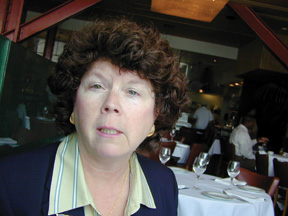Patricia Breslin, Executive Director of the Golden Gate Restaurant Association

Published: July, 2003
The City of San Francisco is more than just a pretty face. It’s also one of the world’s greatest in terms of fine dining. Whom do you call for the straight scoop on the perils and possibilities roiling the restaurant industry? None other than Patricia Breslin, Executive Director of the Golden Gate Restaurant Association (GGRA). Bay Crossings broke bread with her at Chaya Brasserie on the San Francisco Waterfront.
BC: It’s a tough time for restaurants right now, isn’t it?
PB: Very tough. We were amazed at how tough we found it when we did an economic study last year. Our study showed that in San Francisco we were down 288 restaurants in the last six months of 2001.
BC: 288 restaurants closed?
PB: No, 288 more closed. We were down a net of 288 restaurants. I’d say that we’re down 7 percent overall. The public perception is that some open, some close, and that in the end there’s always the same total number. But that’s not true this time. First, we had the dot-com crash, and then the threat of terrorism, next the current war, and now SARS. Add that to workers comp increases, and, well, it’s not a pretty picture.
The public perception is that the restaurant industry is glamorous, that there’s a lot of money in it. The truth is that these places succeed only because of the creativity, ingenuity, and the incredibly hard work of restaurateurs. They work night and day; it only looks easy. It’s a stage, and the customer doesn’t see what’s going on behind the curtain. Customers come for the magic, the magic we all enjoy, and believe me, we have to work harder then ever to keep it up in these tough times.
BC: Are you satisfied that the city did enough to help its number one industry, tourism, in the wake of 9/11?
PB: Right after 9/11, there was a kind of effort to prop up our industry. But in the end, we had to rely on a very local network. There were wonderful marketing programs, which got everyone into a feel-good mode, to get people going out again, like "Open for Business," "Dine About Town." and "Herb Caen Days." The city did a wonderful job of stepping into that marketing role through its Convention & Visitors Bureau. The GGRA partnered with them, we had mutual websites, and basically just encouraged everyone to get their joie de vivre back.
Interestingly, neighborhood restaurants were not traumatized because everyone was nesting in. These restaurants saw a surge in business. But all in all, the restaurant business is really hurting, and where I feel that we’re not positioned correctly with the city is that we are still looked at as a cash cow. We’re being hit with taxes, burdensome rules, and being looked to as a way to solve the current fiscal mess. People don’t appreciate that even in the best of times upper-scale white tablecloth restaurants in San Francisco earn but two and a half cents on the dollar in profit.
BC: That’s not a good return on investment.
PB: No. So why do they do it? They do it for the love of it. That’s what brings somebody to this business. You have to love the business, love sitting down with people, feed off someone appreciating your concept, your preparation, the altogether of a great evening out. That’s why people do it. But restaurateurs need appreciation, too. Or at least a helping hand when they’re down.
BC: What are the specific issues restaurants are unhappy about?
PB: On the statewide level, there are three proposed alcohol tax bills right now. An alcohol tax bill, no matter how you write it, is going to come through the restaurant, and it’s going to go down to the consumer. It’s kind of like the old sin taxes coming back. So, for example, there is a bill proposed to impose a 5 percent sales tax on all alcohol sold. That is huge for us.
Sometimes people lose sight of the fact that hospitality is San Francisco’s number one business. It’s very unusual for a city to rely on the hospitality industry as its number one revenue source. It’s an asset the community needs to protect, the golden goose that makes possible much of the City’s quality of life. I can’t help but feel that if San Francisco were a one-company steel town, and the steel factory were in trouble, that more would be done to help out. We can’t help feeling a bit taken for granted.

